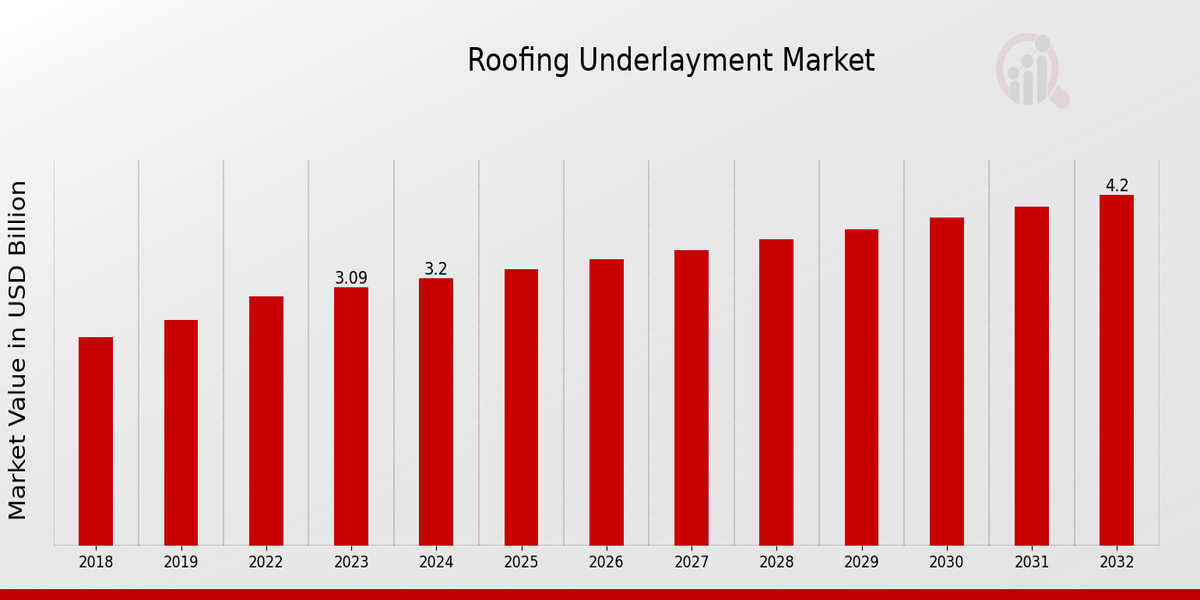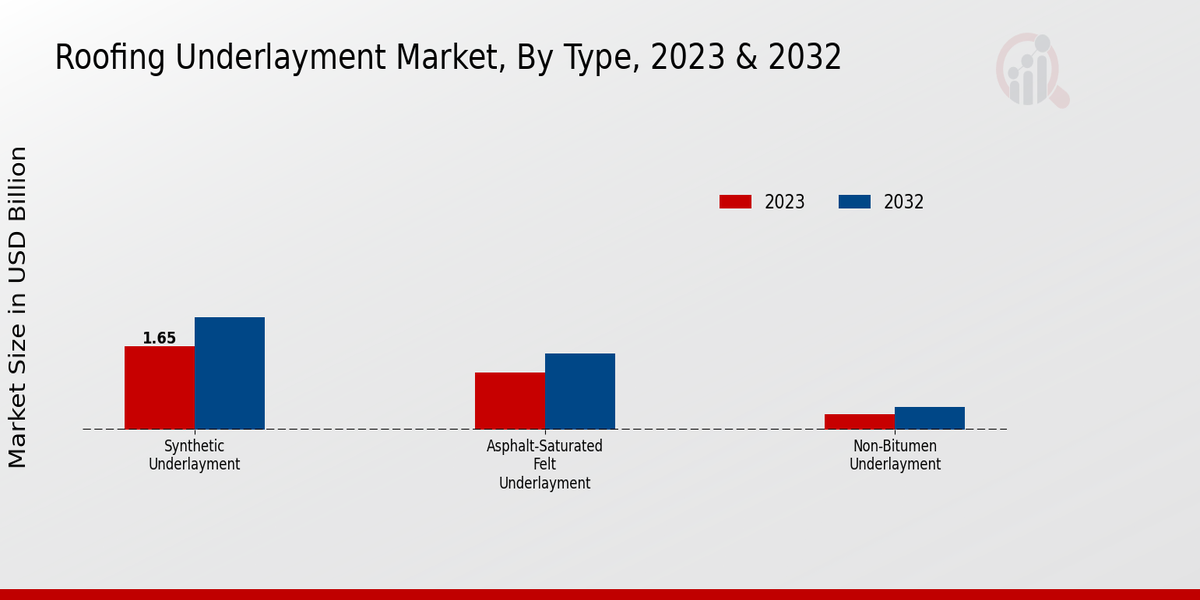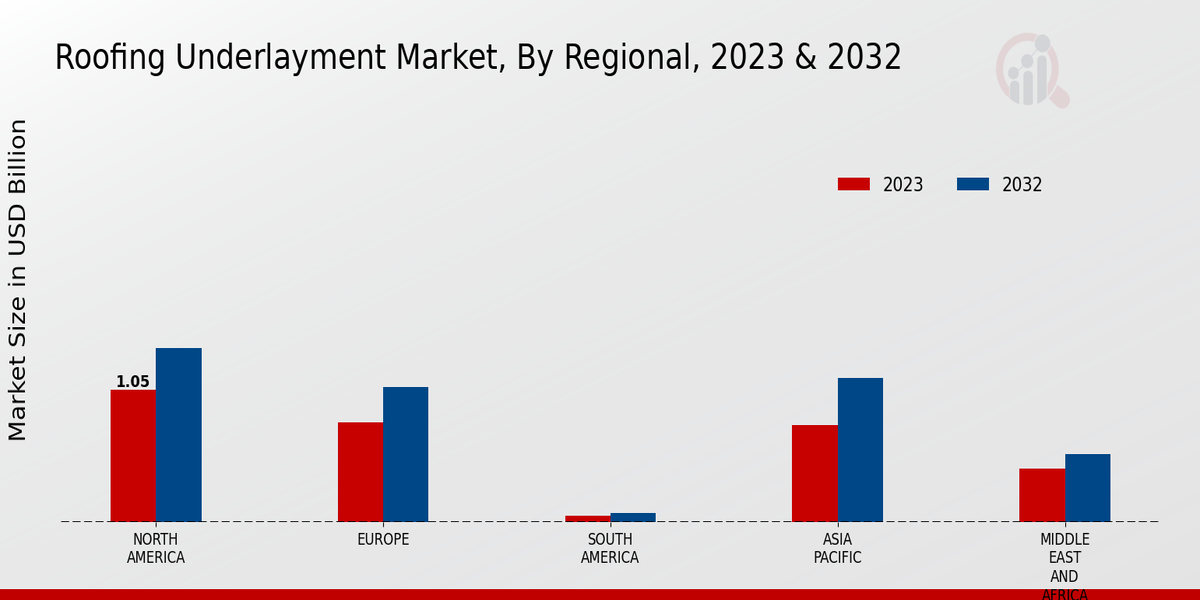Global Roofing Underlayment Market Overview
The Roofing Underlayment Market Size was estimated at 3.31(USD Billion) in 2024. The Roofing Underlayment Industry is expected to grow from 3.43(USD Billion) in 2025 to 4.65(USD Billion) by 2034. The Roofing Underlayment Market CAGR (growth rate) is expected to be around 3.50% during the forecast period (2025 - 2034).
Key Roofing Underlayment Market Trends Highlighted
Growth of the roofing underlayment market is driven by increasing urbanization, rising construction activities, and the growing popularity of energy-efficient buildings. The demand for underlayment is particularly strong in emerging markets where rapid infrastructure development is underway.Opportunities for the roofing underlayment market lie in the exploration of eco-friendly and sustainable materials, as well as the development of innovative products that enhance performance and ease of installation. The growing adoption of smart building technologies also presents opportunities for integrated underlayment systems with sensors and monitoring capabilities.Recent trends in the roofing underlayment market include the increasing use of synthetic underlayments due to their durability and resistance to moisture. Advances in manufacturing technology have resulted in the development of underlayments with enhanced breathability and puncture resistance. Furthermore, there is a growing demand for slip-resistant underlayments to ensure safety during installation and maintenance.

Source: Primary Research, Secondary Research, MRFR Database and Analyst Review
Roofing Underlayment Market Drivers
Increasing Demand for Sustainable Building Materials
The Roofing Underlayment Market is expected to witness significant growth in the coming years, driven by the increasing demand for sustainable building materials. Roofing underlayment is an important component of a roofing system, as it helps to protect the roof from water damage and other elements. Traditional roofing underlayments are often made from non-renewable resources, such as asphalt or plastic. However, there is a growing demand for more sustainable roofing underlayments, made from recycled materials or renewable resources.Sustainable roofing underlayments are more environmentally friendly and can help to reduce the carbon footprint of a building. As a result of these factors, the market for sustainable roofing underlayment is expected to grow at a rapid pace in the coming years.In addition to the increasing demand for sustainable building materials, there are a number of other factors that are expected to drive growth in the Roofing Underlayment Market. These factors include the growing population, the increasing number of new construction projects, and the rising disposable income of consumers.The growing population is leading to an increased demand for housing, which in turn is driving up the demand for roofing underlayment. The increasing number of new construction projects is also contributing to the growth of the roofing underlayment market. As more and more new buildings are constructed, there is a need for more roofing underlayment to protect these buildings from the elements. Finally, the rising disposable income of consumers is also driving up the demand for roofing underlayment.As consumers have more money to spend, they are more likely to invest in home improvement projects, such as replacing their roof. All of these factors are expected to contribute to the growth of the Roofing Underlayment Market in the coming years.
Government Regulations Promoting Energy Efficiency
The increase of the Roofing Underlayment Market is also a result of government regulations that promote energy efficiency. There are many regulations in different countries that demand new buildings meet certain energy-efficient requirements. They make the demand for roofing underlayment rise, as it can help to effectively improve the energy efficiency of a building. It prevents heat loss in winter and heat gain in summer. In its turn, the energy-efficient technology results in lower energy bills.These regulations will make the demand for roofing underlayment grow in the future.
Technological Advancements Improving Product Performance
In the global market for roofing underlayment, growth is expected to be driven by technological developments. Indeed, in recent years, there have been several technological advances that have allowed for a more effective application of roofing underlayment. To start, new materials have been developed, capable of making more resistant and durable underlayment. The existence of synthetic underlayment is a direct result of these technologies. Additionally, new manufacturing technologies have been developed, such as extrusion, which may allow for more efficient processes and a higher degree of underlayment quality consistency.As such, the demand for roofing underlayment is expected to increase in the following years.
Roofing Underlayment Market Segment Insights
Roofing Underlayment Market Type Insights
The Roofing Underlayment Market segmentation by Type involves classifying the market based on different types of underlayment materials used in roofing systems. The key types include Synthetic Underlayment, Asphalt-Saturated Felt Underlayment, Non-Bitumen Underlayment, and Other Underlayment. Synthetic Underlayment is gaining significant popularity due to its superior performance and durability. It is made from synthetic materials such as polypropylene or polyethylene and offers excellent water resistance, tear resistance, and puncture resistance.Its lightweight and ease of installation make it a preferred choice for both residential and commercial roofing applications. Asphalt-Saturated Felt Underlayment is a traditional and widely used type of underlayment. It consists of organic felt saturated with asphalt, providing a waterproof barrier and protecting the roof deck from moisture damage. However, it is susceptible to degradation over time and requires replacement more frequently than synthetic underlayment. Non-Bitumen Underlayment, also known as breathable underlayment, allows moisture vapor to escape from the roof deck while preventing water penetration.It is commonly made from materials like spunbound polypropylene or non-woven polyester and is often used in areas with high humidity or temperature fluctuations. This type of underlayment helps prevent moisture accumulation and potential damage to the roof structure. Other Underlayment types include specialized products tailored to specific roofing needs. For instance, self-adhering underlayment offers ease of installation and excellent adhesion to the roof deck. Radiant barrier underlayment reflects heat, reducing energy consumption and improving attic comfort.The Roofing Underlayment Market revenue for the Type segment is expected to exhibit steady growth in the coming years. The increasing demand for durable, energy-efficient, and sustainable roofing solutions is driving the market expansion. The growing adoption of synthetic underlayment and non-bitumen underlayment, owing to their superior performance and longevity, is further contributing to the market growth.

Source: Primary Research, Secondary Research, MRFR Database and Analyst Review
Roofing Underlayment Market Application Insights
The Roofing Underlayment Market segmentation by Application is divided into Residential and Non-Residential (Commercial, Industrial). The Residential segment is expected to account for a larger share of the Roofing Underlayment Market revenue in 2023 and is projected to continue its dominance throughout the forecast period. This growth is attributed to the increasing demand for roofing underlayment in residential construction projects. The Non-Residential segment is also expected to witness significant growth during the forecast period, driven by the rising demand for roofing underlayment in commercial and industrial buildings.The increasing adoption of energy-efficient roofing systems and the growing trend of sustainable construction are expected to drive the growth of the Roofing Underlayment Market in both residential and non-residential sectors.
Roofing Underlayment Market Roof Type Insights
The Roofing Underlayment Market is segmented by roof type into pitched roof and flat roof. The pitched roof segment is expected to account for a larger share of the market in 2023, owing to the increasing popularity of pitched roofs in residential and commercial buildings. The flat roof segment is expected to grow at a faster rate during the forecast period, due to the growing demand for flat roofs in commercial and industrial buildings. In 2023, the pitched roof segment is expected to be valued at 2.03 Billion USD, while the flat roof segment is expected to be valued at 1.06 Billion USD.By 2032, the pitched roof segment is expected to be valued at 2.75 Billion USD, while the flat roof segment is expected to be valued at 1.45 Billion USD. The growth of the Roofing Underlayment Market is expected to be driven by the increasing demand for roofing underlayment in both residential and commercial buildings.
Roofing Underlayment Market End-Use Insights
The Roofing Underlayment Market is segmented by End-Use into New Construction and Repair and Replacement. The New Construction segment accounted for a larger share of the market in 2023, owing to the increasing number of new construction projects worldwide. The Repair and Replacement segment is expected to grow at a faster CAGR during the forecast period, due to the rising demand for roofing repairs and replacements as a result of aging infrastructure and extreme weather events. In 2023, the New Construction segment was valued at around 1.86 (USD Billion), and it is projected to reach approximately 2.6 (USD Billion) by 2032.The Repair and Replacement segment was valued at around 1.23 (USD Billion) in 2023 and is expected to reach approximately 1.6 (USD Billion) by 2032.
Roofing Underlayment Market Regional Insights
The regional segmentation of the Roofing Underlayment Market provides insights into the market's geographical distribution and growth potential. North America is projected to dominate the market in 2023, accounting for a significant share of the Roofing Underlayment Market revenue. This dominance is driven by the region's robust construction industry and increasing adoption of advanced roofing solutions. Europe is another key market, with a strong demand for eco-friendly and energy-efficient roofing materials. The APAC region is expected to witness significant growth over the forecast period, driven by rapid urbanization and rising disposable incomes.South America and MEA also offer growth opportunities, with increasing investments in infrastructure and construction projects.

Source: Primary Research, Secondary Research, MRFR Database and Analyst Review
Roofing Underlayment Market Key Players And Competitive Insights
Major players in Roofing Underlayment Market industry are constantly striving to gain a competitive edge over one another. Leading Roofing Underlayment Market players are investing heavily in research and development to create innovative products and solutions that meet the evolving needs of customers. The Roofing Underlayment Market development landscape is highly competitive, with key players focusing on expanding their global reach, enhancing their product portfolios, and adopting advanced technologies to gain market share. Companies are also forming strategic partnerships, collaborations, and acquisitions to strengthen their position in the market. The Roofing Underlayment Market Competitive Landscape is expected to remain dynamic, with intense competition among established players and emerging entrants vying for market dominance.GAF, a leading company in the Roofing Underlayment Market, offers a wide range of underlayment products, including synthetic, felt, and self-adhered underlayments. The company's products are known for their durability, water resistance, and ease of installation. GAF has a strong distribution network and a loyal customer base, which has contributed to its success in the market.CertainTeed, a competitor in the Roofing Underlayment Market, is another major player with a comprehensive product line. The company's underlayment products include synthetic, felt, and self-adhered underlayments, as well as a range of accessories. CertainTeed has a well-established brand reputation and a strong distribution network. The company is focused on providing innovative products and solutions to meet the needs of its customers.
Key Companies in the Roofing Underlayment Market Include
- Atlas Roofing Corporation
- Carlisle Companies Incorporated
- GAF
- Owens Corning
- IKO Industries
- Johns Manville Corporation
- BMI Group
- Dorken Gmbh Kg
- Siplast
- Sarnafil
- CertainTeed
- Soprema Entreprises
- Sika Ag
- Firestone Building Products
- Bauder
- Versico Roofing System
Roofing Underlayment Market Industry Developments
The market growth is attributed to rising construction activities, increasing demand for energy-efficient building materials, and government regulations mandating the use of underlayment in roofing systems.Recent developments in the market include the introduction of innovative underlayment products such as self-adhesive membranes and synthetic underlayments. These products offer improved performance, ease of installation, and durability, driving their adoption in the construction industry. Additionally, the growing popularity of green building practices is creating demand for eco-friendly underlayment materials such as recycled paper and plant-based fibers.
Roofing Underlayment Market Segmentation Insights
- Roofing Underlayment Market Type Outlook
- Synthetic Underlayment
- Asphalt-Saturated Felt Underlayment
- Non-Bitumen Underlayment
- Other Underlayment
- Roofing Underlayment Market Application Outlook
- Residential
- Non-Residential (Commercial, Industrial)
- Roofing Underlayment Market Roof Type Outlook
- Roofing Underlayment Market End-Use Outlook
- New Construction
- Repair and Replacement
| Report Attribute/Metric |
Details |
| Market Size 2024 |
3.31(USD Billion) |
| Market Size 2025 |
3.43(USD Billion) |
| Market Size 2034 |
4.65(USD Billion) |
| Compound Annual Growth Rate (CAGR) |
3.50% (2025 - 2034) |
| Report Coverage |
Revenue Forecast, Competitive Landscape, Growth Factors, and Trends |
| Base Year |
2024 |
| Market Forecast Period |
2025 - 2034 |
| Historical Data |
2020 - 2024 |
| Market Forecast Units |
USD Billion |
| Key Companies Profiled |
Atlas Roofing Corporation ,Carlisle Companies Incorporated ,GAF ,Owens Corning ,IKO Industries ,Johns Manville Corporation ,BMI Group ,Dorken Gmbh Co. Kg ,Siplast ,Sarnafil ,CertainTeed ,Soprema Entreprises ,Sika Ag ,Firestone Building Products ,Bauder ,Versico Roofing System |
| Segments Covered |
Type ,Application ,Roof Type ,End-Use ,Regional |
| Key Market Opportunities |
Synthetic underlayments Waterproofing underlayments Roofing underlayment accessories Energyefficient roofing underlayments Commercial roofing underlayments |
| Key Market Dynamics |
Rising demand for energyefficient green buildings Growing popularity of synthetic underlayments Technological advancements Increasing awareness of building codes Growing emphasis on sustainability |
| Countries Covered |
North America, Europe, APAC, South America, MEA |
Frequently Asked Questions (FAQ) :
The Roofing Underlayment Market is anticipated to reach an overall valuation of 3.43 USD Billion in 2025.
The Roofing Underlayment Market is projected to reach an overall valuation of 4.65 USD Billion by 2034, exhibiting a CAGR of 3.50% from 2025 to 2034.
Key regions driving the growth of the Roofing Underlayment Market include North America, Asia Pacific, Europe, Latin America, and the Middle East Africa.
Major applications of Roofing Underlayment include residential roofing, commercial roofing, and industrial roofing.
Key competitors in the Roofing Underlayment Market include GAF, CertainTeed, IKO Industries, Owens Corning, and Johns Manville.
Primary growth drivers of the Roofing Underlayment Market include increasing construction activities, rising demand for sustainable building materials, and growing awareness about the benefits of Roofing Underlayment.
Challenges faced by the Roofing Underlayment Market include fluctuations in raw material prices, competition from alternative roofing materials, and stringent government regulations.
The COVID-19 pandemic had a moderate impact on the Roofing Underlayment Market, causing temporary disruptions in supply chains and construction activities. However, the market is expected to recover and continue growing post-pandemic.
Key trends shaping the Roofing Underlayment Market include the adoption of eco-friendly materials, technological advancements, and increasing focus on energy efficiency.
The future outlook for the Roofing Underlayment Market is positive, with continued growth expected in the coming years. Factors such as rising disposable income, increasing urbanization, and growing awareness about the importance of roofing infrastructure will drive market expansion.

















